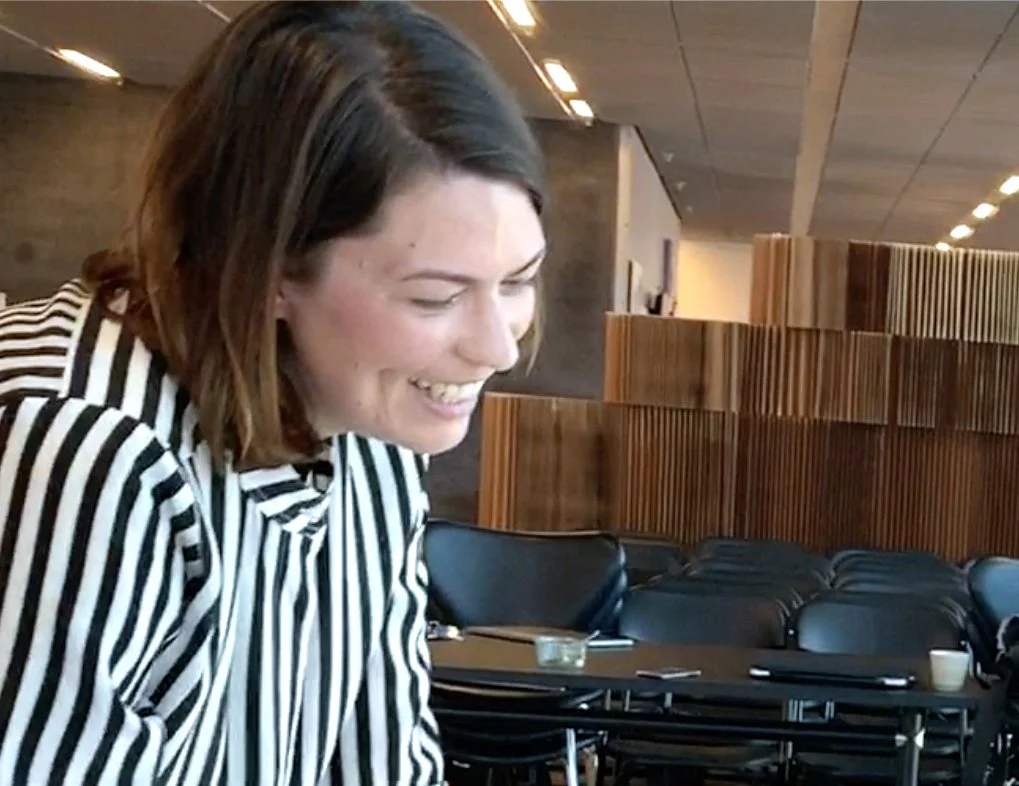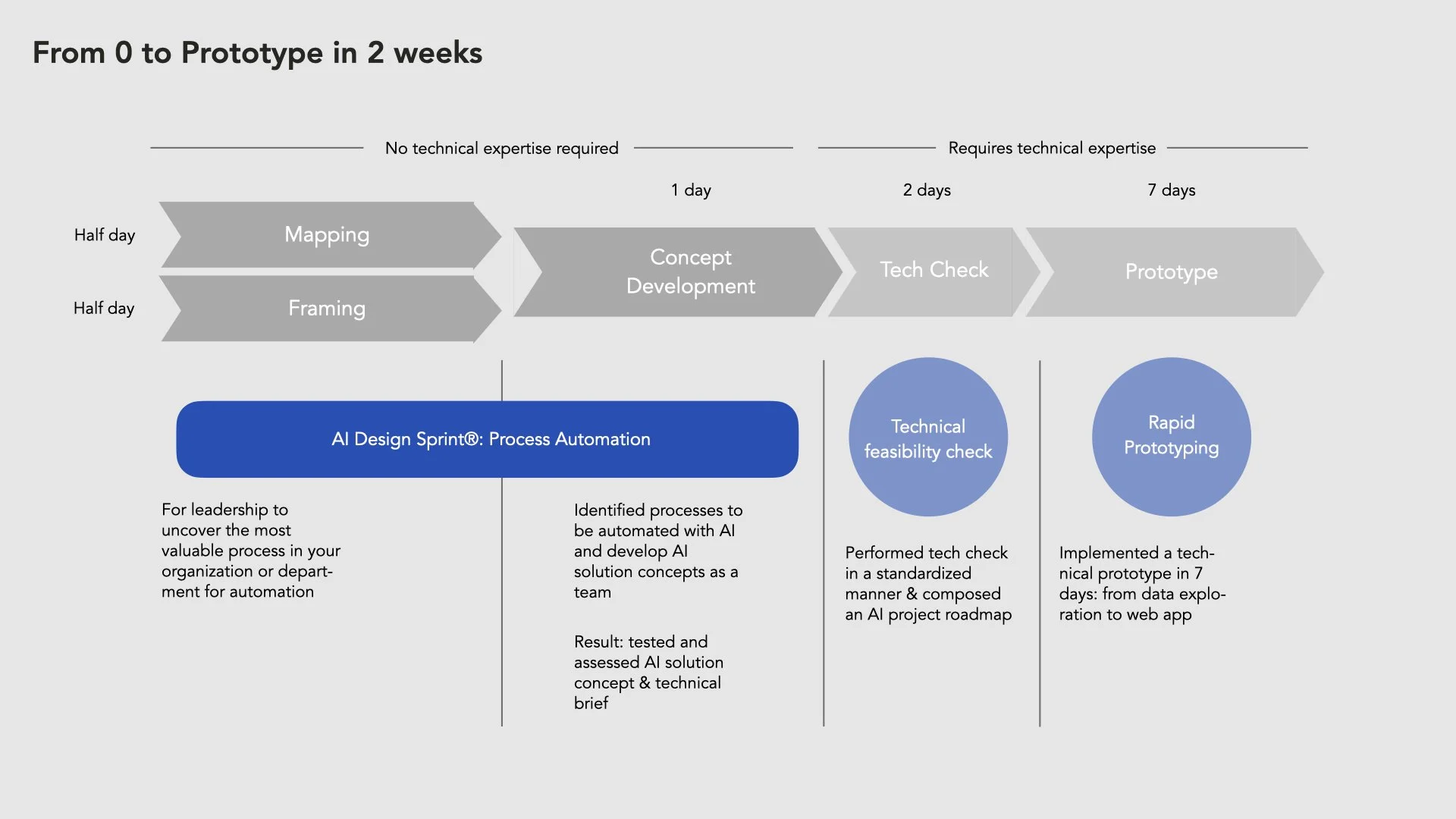
What Process Automation is
It means that not only would businesses run partially on their own, but much better. It truly transforms businesses! Potential gains include:
Efficiency and Speed
Accuracy and Precision
Predictive Capabilities
Customization and Personalization
Training & Certification in the AI Design Sprint®: Process Automation
Company Team Training
For up to eight participants — live and remote over four half-days, scheduled at your convenience. Prefer in-person? We can deliver onsite over two days for an additional fee.
Cost Reduction
Scalability
Enhancing Human Capabilities
Innovative Potential
Bootcamp
Individual sign-up — we group 6–8 participants from different organizations. Delivered live and remotely — see our upcoming dates.

What the AI Design Sprint®: Process Automation is
It’s a structured method for creating tailored AI applications that partly or fully automate workflows.
For consultants, it’s a proven way to launch AI projects with non-technical decision-makers.
For in-house teams, it brings business and technical people together to collaborate effectively and define high-value AI use cases.
It’s fast—taking you from zero to prototype in just two weeks—and works equally well remotely or onsite.

If the team hasn’t yet identified a process for automation and is asking, ‘Where do we start with AI applications?’, you guide them through the “Opportunity Mapping” format to find the best starting point.
Input for Opportunity Mapping
The organization chart, value stream, or mapped business areas.
Phases
Analyze the input – Review the org chart, value stream, or mapped areas in detail.
Identify AI opportunities – Consider the full range of AI capabilities to uncover potential applications.
Prioritize opportunities – First, rank by impact/business value; then by costs. Keep the AI strategy in mind (e.g., Start Small, Scale Smart; focus on a cluster of use cases; follow a North Star use case).
Output
Clear identification of processes suited for automation.

If the team is focusing on just one department’s processes instead of the whole organization—welcome to the “Framing” format.
Input: mapped overview of all tasks within the department.
Output: two focus areas where AI can deliver the greatest value.

Overview of the AI Design Sprint®: Process Automation formats, followed by “Tech Check” and “Prototype”, shown in a timeline.

We have now reached the main format, “Concept Development & Assessment”, where the team designs a tailored automation solution—including the people currently performing the workflow.
To prepare for this session, we map the process identified by the client or in-house team, or the one emerging from “Opportunity Mapping” or “Framing”.
During Concept Development & Assessment:
The session includes these phases:
Analysis of the current work process
Matching AI technology to workflow steps using our AI Cards®, and mapping the new process with AI integrated
Ethical check of the solution
Technical feasibility assessment, with a focus on data
Value assessment for employees
Value assessment for the business
Output: The AI Design Sprint®: Process Automation produces a technical brief describing the AI solution and its functionalities, identifying relevant data sources, and outlining the initial technical complexity.

Concept Development & Assessment
This is the main session where the entire client or in-house team—including the people currently performing the workflow—develops a tailored AI application concept.
Mapping the current workflow:
Before this session, we map the process identified by the client or in-house team, or one emerging from Opportunity Mapping or Framing.
During Concept Development & Assessment:
The session includes these phases:
Analysis of the current work process
Matching AI technology to workflow steps using our AI Cards®, and mapping the new process with AI integrated
Ethical check of the solution
Technical feasibility assessment, with a focus on data
Value assessment for employees
Value assessment for the business
Output: The AI Design Sprint®: Process Automation produces a technical brief describing the AI solution and its functionalities, identifying relevant data sources, and outlining the initial technical complexity.

What happens after the AI Design Sprint®: Process Automation
Tech Check
An AI technical expert conducts a feasibility check to determine how the solution concept can be brought to life. The findings are presented, and the prototype scope is defined.
Prototype
A technical prototype is built with real data within seven days.

What to expect in the training & certification
The training will be interactive, high-energy, fast-paced, and focused on learning by doing.
Company Team Training
Participants: Up to 8 colleagues
Format: Remote, live (onsite within Europe available; additional travel and accommodation fee for two trainers)
Timing: At your convenience — Remote: 4 × 4 hours | Onsite: 2 days
Agenda
In the training & certification we go from left to right through the timeline of the AI Design Sprint®: Process Automation.
First half-day: Opportunity Mapping for Process Automation and Framing
Second half-day: Concept Development & Assessment
Third half-day: Preparation templates and facilitation of Concept Development & Assessment
Fourth half-day: GenAI for Process Automation, outlook on Tech Check and Prototype, and answering technical questions
Bootcamp
Participants: Individual sign-up; we group 6–8 participants from different organizations
Format: Remote, live
Timing: See our upcoming dates

What you’ll get
Starter Kit: Prior to the training you will receive our physical Starter Kit with all cards—AI Cards®, Ethical Risk Mitigation Cards, Data Sources Cards, Resources & Roles Cards, AI Category Cards, GenAI Cards.
Training: You will be Certified AI Design Sprint® Facilitator
Format: Remote, live (onsite within Europe available; additional travel and accommodation fee for two trainers)
Timing: At your convenience — Remote: 4 × 4 hours | Onsite: 2 days









